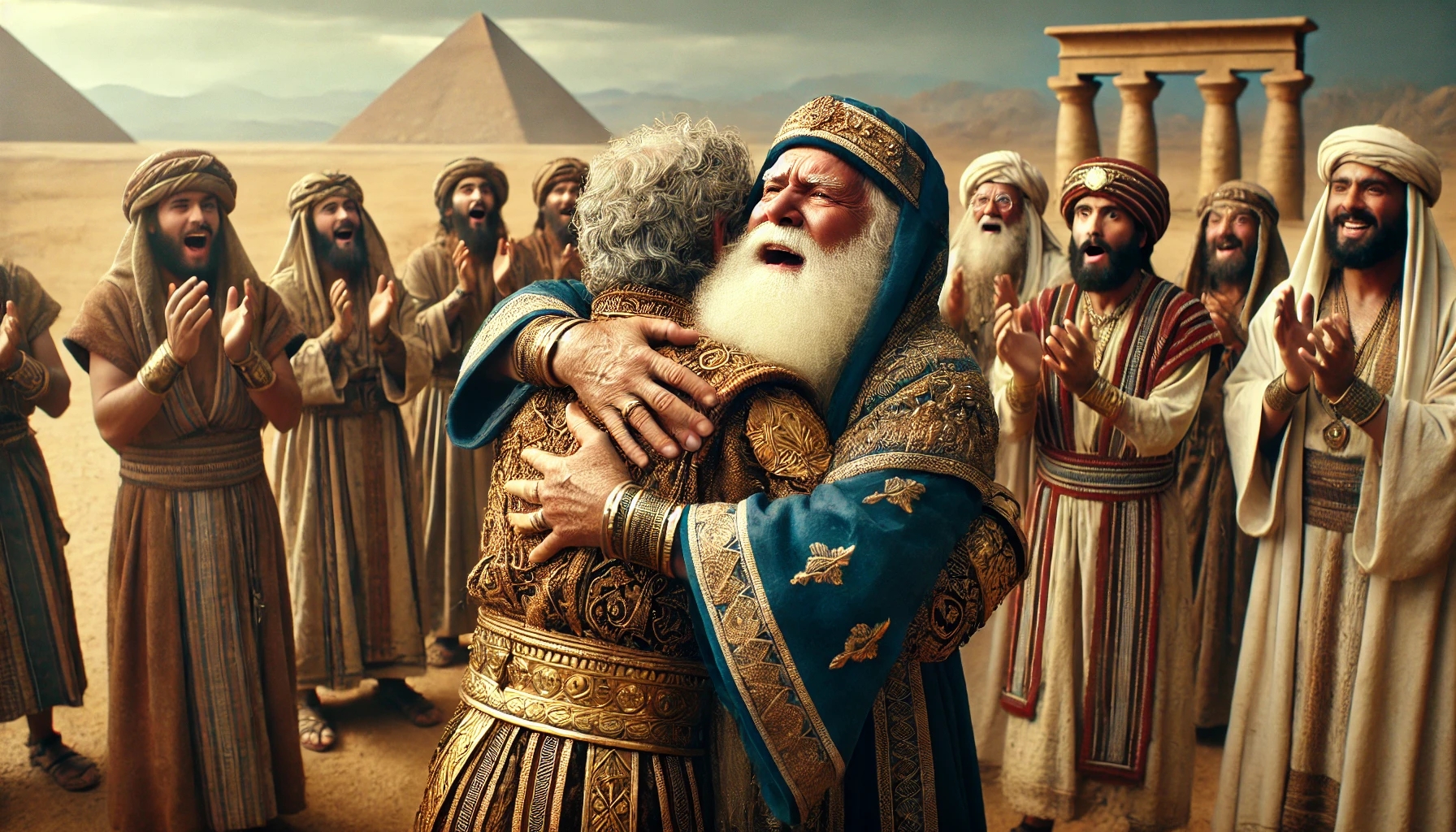 August 8, 2025
August 8, 2025
 Joseph – Faith That Endures
Joseph – Faith That Endures
Devotions from the life of a dreamer with character
 14.God Works in the Dark
14.God Works in the Dark
When everything is silent – yet something happens
 Introduction
Introduction
There are times when God seems silent. No ray of light, no answer, no sign. We ask: Where is God? Has He forgotten me? Yet precisely in those moments when we see the least, He is often at work the most.
Joseph sat in prison – seemingly abandoned and forgotten. But while he waited, God was already preparing the turning point. God was working – in secret, in silence, in the dark.
──────────────── ────────────────
────────────────
 Devotional
Devotional
“The Lord will fight for you, and you shall be silent.”
Exodus 14:14
Darkness often feels like the end. No light, no direction, no clarity. Everything in us screams for action, for answers, for a way out. But sometimes God doesn’t say, “Do something,” but rather, “Be still. I am acting.”
For Joseph, prison was not a temporary pause but a long season of uncertainty. No plan, no perspective, no call from the palace. And yet – it was in that very darkness that God wrote history. Not visibly, but effectively. Not loudly, but purposefully. Unseen – but not inactive.
This is a biblical principle:
God does not only work when the curtain rises – but behind the scenes.
In Exodus 14, the Israelites stood with their backs to the Red Sea and the Egyptian army approaching. All seemed lost. And yet God didn’t say: “Fight.” He said: “I will fight for you. You shall be still.”
To be still – while the danger approaches? That’s not giving up. It’s radical trust.
God’s silence is never indifference.
His waiting is never forgetfulness.
His darkness is never emptiness – but preparation.
Joseph couldn’t force Pharaoh’s dream. He couldn’t open a door. But he remained faithful. He served. He waited. And in that very waiting, his character was shaped. The years in secret made him ready for the task ahead. God doesn’t form leaders on stage – but in prison.
What grows in the dark develops deep roots.
What is shaped in silence often bears the richest fruit.
We live in a time that celebrates action, speed, and results. But God’s kingdom works differently. With Him, it’s not about how fast we see something – but how deeply we trust, even when we see nothing.
Remember the disciples when Jesus lay dead in the tomb? Three days of darkness. Hopelessness. And yet – in that very darkness, God performed the greatest miracle in history.
Resurrection doesn’t begin with light – but with a sealed tomb.
So remember:
-
Don’t confuse God’s silence with His absence.
-
Don’t lose trust in the fog.
-
Don’t give up while waiting – God is still working.
And if you’re in a dark season today, remember:
God is already on the move. Maybe you don’t see it, but He is preparing something.
Maybe not what you expected – but exactly what you need.
“See, darkness covers the earth and thick darkness is over the peoples,
but the LORD rises upon you and His glory appears over you.”
— Isaiah 60:2
──────────────── ────────────────
────────────────
 Reflection – What Does This Mean for You?
Reflection – What Does This Mean for You?
-
Just because you don’t see God doesn’t mean He’s not there.
-
Just because it’s quiet doesn’t mean He isn’t speaking.
-
Just because you feel stuck doesn’t mean nothing is moving.
God’s ways are higher than ours (Isaiah 55:9).
And His timing is not our timing.
Waiting time is not wasted time. It’s preparation time.
──────────────── ────────────────
────────────────
 What We Can Learn from Joseph
What We Can Learn from Joseph
-
Patience in the dark means trust in the light.
-
God does not forget us – even if people do.
-
While we wait, we can stay faithful – that opens the door to God’s work.
-
Our story doesn’t end in prison – but in God’s plan.
──────────────── ────────────────
────────────────
 Reflection – What Does This Mean for You?
Reflection – What Does This Mean for You?
-
Is there an area in your life that feels “dark”?
-
What helps you trust God in the silence?
-
Can you remember a time when you only recognized God’s work in hindsight?
-
Where could you be faithful today, even without seeing change?
──────────────── ────────────────
────────────────
 Story – “A Light in the Night”
Story – “A Light in the Night”
Chapter 1 – The Fall
Klara was 42, a teacher with heart and soul, married, two children. Her life was structured, full, and bursting with energy. But then, during a routine check-up, the diagnosis hit like a hammer: breast cancer – advanced.
“This can’t be,” she whispered at the time, as the doctor spoke with a grave expression. “I’m healthy… I have plans…”
That very day, the storm began: biopsies, conversations, decisions. Her long hair – cut off. Her full calendar – emptied. Her strength – broken.
✦ ─────────────── ✦ ─────────────── ✦
Chapter 2 – The Darkness
The first chemotherapy sessions were brutal. Nausea, weakness, sleepless nights. Klara withdrew – from colleagues, from friends, even from God.
She could no longer pray. Everything felt empty.
“Where are you, Lord?” she wrote in her journal. “I can’t feel you. I can’t see you. I don’t understand you.”
Her faith, once a rock, now felt like sand slipping through her fingers. The church service on the screen flickered without depth. Her Bible remained closed. Her hope seemed lost.
✦ ─────────────── ✦ ─────────────── ✦
Chapter 3 – The Letter
Three weeks later, she found a letter in her mailbox. Handwritten. No sender.
“You are seen. You are not alone. God is carrying you, even when you can’t feel Him.”
Klara set the letter aside – moved, but skeptical.
“Just words,” she murmured.
And yet: something kept her from throwing it away.
The following week, another arrived. This time with a Bible verse:
“Even though I walk through the darkest valley – you are with me.”
Psalm 23:4
Klara began keeping every letter. She read them at night – sometimes through tears, sometimes with a faint smile. Verses, prayers, little encouragements arrived. Always at the right time. Always like a whisper in the dark.
✦ ─────────────── ✦ ─────────────── ✦
Chapter 4 – The Encounter
At the clinic, Klara met a young woman: Mia, in her early 30s, also battling cancer, full of fear and anger.
“I don’t know if I can do this,” Mia said softly one morning at breakfast. “I have no one. And God…? He’s silent anyway.”
Klara paused. Then she said:
“Sometimes He speaks through others. I’ve been getting letters for weeks. I don’t know who from. But they help me believe I’m not forgotten.”
Mia looked at her in surprise.
“You mean… you still believe?”
Klara nodded.
“Not always strongly. But yes. I hold on – even in the fog.”
✦ ─────────────── ✦ ─────────────── ✦
Chapter 5 – The Sender
Shortly before her final treatment, Klara happened to meet an older woman in the clinic hallway – Ruth, a former colleague, long since retired.
“I’ve had you on my heart often,” Ruth said gently. “I… wrote you sometimes. Just little thoughts. I didn’t know if you ever got them.”
Klara swallowed hard. Her eyes filled with tears.
“It was you?”
Ruth nodded and smiled warmly.
“I just wanted you to know: You are not alone.”
✦ ─────────────── ✦ ─────────────── ✦
Chapter 6 – The Realization
That evening, Klara prayed out loud for the first time again:
“Lord,
I thought You were silent.
But You spoke through Ruth.
I believed You didn’t see me –
but You wrote me letters.
Thank You.
I’m not healed – but I am held.”
She realized: God had never stopped working.
Not on a grand stage.
Not with lightning and thunder.
But in silence. In secret. In the dark.
✦ ─────────────── ✦ ─────────────── ✦
Chapter 7 – The Way Back
Months later, Klara sat once again in church – weak, but upright. When asked to share a testimony, she stood hesitantly.
“I’m not at the finish line yet,” she began.
“But I’ve learned: God’s greatest miracles often happen when we think nothing is happening at all.
He works – even when we see nothing.
And sometimes, the light comes – in the form of a handwritten letter.”
✦ ─────────────── ✦ ─────────────── ✦
 Lessons from the Story
Lessons from the Story
-
God doesn’t need light to work – His power unfolds even in darkness.
-
People can carry God’s hope without even realizing it.
-
Silence doesn’t mean absence. Sometimes God speaks softer so we listen closer.
-
The strongest steps of faith aren’t taken in the light – but by trusting through the night.
──────────────── ────────────────
────────────────
 Application
Application
-
Remember God’s faithfulness in past dark times.
-
Speak a word of hope today to someone who is waiting.
-
Trust that God is acting – even if you don’t see it yet.
──────────────── ────────────────
────────────────
 Prayer
Prayer
Lord,
sometimes I see nothing – and doubt everything.
But You are faithful, even when I can’t feel You.
Help me trust You when everything feels dark.
Let me believe that You are working –
especially in the silence.
Give me patience, hope, and an open heart
for Your hidden ways.
Amen.
──────────────── ────────────────
────────────────
 Key Thought of the Day
Key Thought of the Day
God works in the dark – silently, hidden, but powerfully.
──────────────── ────────────────
────────────────
 Blessing to Close
Blessing to Close
The Lord, who did not forget Joseph in the pit,
be your light in your darkness.
May He strengthen your trust,
open your eyes to His quiet work,
and lead you from night into the light of His promise.
──────────────── ────────────────
────────────────
LumenCorde | Daily light for a living soul.

 THE SECOND BOOK OF MOSES
THE SECOND BOOK OF MOSES Lesson 6: Through the Red Sea
Lesson 6: Through the Red Sea 6.5 The Song of Moses and Miriam
6.5 The Song of Moses and Miriam Praise After the Victory
Praise After the Victory Introduction
Introduction Bible Study – The Song of Moses (Exodus 15:1–21)
Bible Study – The Song of Moses (Exodus 15:1–21) 1. God’s Victory over the Enemies (vv. 1–10)
1. God’s Victory over the Enemies (vv. 1–10) Question 1: Read Exodus 15:1–21. What is the content of Moses’ song?
Question 1: Read Exodus 15:1–21. What is the content of Moses’ song? Practical Life Application
Practical Life Application Conclusion
Conclusion Thought of the Day
Thought of the Day Learn to raise your voice today—not because everything is fine, but because God is faithful.
Learn to raise your voice today—not because everything is fine, but because God is faithful. Illustration – The Sound Behind the Storm
Illustration – The Sound Behind the Storm 07 August 2025
07 August 2025 BELIEVE HIS PROPHETS
BELIEVE HIS PROPHETS Daily Bible Reading
Daily Bible Reading Leviticus 23 – The Feasts of the Lord – Signs of Divine Fellowship
Leviticus 23 – The Feasts of the Lord – Signs of Divine Fellowship God’s Holy Calendar: Insights into the Nature of His Redemption
God’s Holy Calendar: Insights into the Nature of His Redemption Bible Text – Leviticus 23 (KJV)
Bible Text – Leviticus 23 (KJV) Introduction
Introduction Commentary
Commentary 1. The Sabbath (v. 3)
1. The Sabbath (v. 3) Summary
Summary Message for Us Today
Message for Us Today Reflection Questions
Reflection Questions Which of these feasts speaks to me especially today?
Which of these feasts speaks to me especially today?
 Ellen White | Patriarchs and Prophets – Chapter 21
Ellen White | Patriarchs and Prophets – Chapter 21 Joseph and His Brothers
Joseph and His Brothers Read online
Read online  1. Foresight and Responsibility (Genesis 41)
1. Foresight and Responsibility (Genesis 41) Reflection Question
Reflection Question August 7, 2025
August 7, 2025 Joseph – Faith That Endures
Joseph – Faith That Endures 13.Imprisoned, Yet Free in Heart
13.Imprisoned, Yet Free in Heart Introduction
Introduction Devotional
Devotional What We Can Learn from Joseph
What We Can Learn from Joseph Reflection – What Does This Mean for You?
Reflection – What Does This Mean for You? Story – “The Patient with the Open Heart”
Story – “The Patient with the Open Heart” Lessons from the Story
Lessons from the Story Application
Application Prayer
Prayer Blessing to Close
Blessing to Close
 THE SECOND BOOK OF MOSES
THE SECOND BOOK OF MOSES Lesson 6: Through the Red Sea
Lesson 6: Through the Red Sea 6.4 Marching Forward by Faith
6.4 Marching Forward by Faith Trust Despite Fear
Trust Despite Fear Introduction
Introduction Bible Study – Exodus 14:13–31
Bible Study – Exodus 14:13–31 1.“Do not be afraid” – The first step to freedom (v. 13)
1.“Do not be afraid” – The first step to freedom (v. 13) Question: Read Exodus 14:13–31. What did God do for the children of Israel despite their lack of faith?
Question: Read Exodus 14:13–31. What did God do for the children of Israel despite their lack of faith? Practical Life Application
Practical Life Application Conclusion
Conclusion Thought of the Day
Thought of the Day Illustration – “The Path Through the Sea”
Illustration – “The Path Through the Sea”